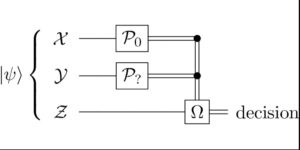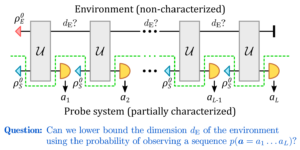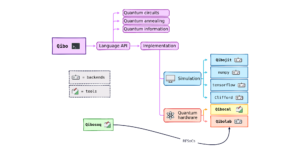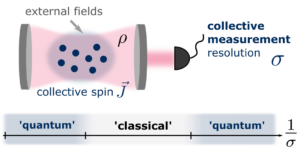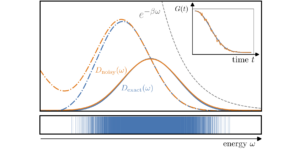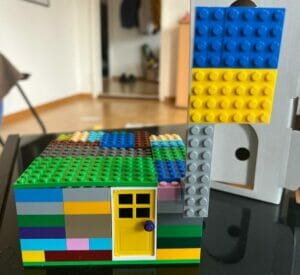
1ICFO – Institut de Ciencies Fotoniques, The Barcelona Institute of Science and Technology, 08860 Castelldefels, Barcelona, Spain
2Instituto de Física Fundamental IFF-CSIC, Calle Serrano 113b, Madrid 28006, Spain
3Instituto Milenio de Investigación en Óptica y Departamento de Física, Facultad de Ciencias Físicas y Matemáticas, Universidad de Concepción, Casilla 160-C, Concepción, Chile
Find this paper interesting or want to discuss? Scite or leave a comment on SciRate.
Abstract
We present an analytical method to estimate pure quantum states using a minimum of three measurement bases in any finite-dimensional Hilbert space. This is optimal as two bases are insufficient to construct an informationally complete positive operator-valued measurement (IC-POVM) for pure states. We demonstrate our method using a binary tree structure, providing an algorithmic path for implementation. The performance of the method is evaluated through numerical simulations, showcasing its effectiveness for quantum state estimation.
► BibTeX data
► References
[1] M. Paris and J. Řeháček, eds., Quantum State Estimation (Springer Berlin Heidelberg, 2004).
https://doi.org/10.1007/b98673
[2] D. F. V. James, P. G. Kwiat, W. J. Munro and A. G. White, Measurement of qubits, Phys. Rev. A 64, 052312 (2001).
https://doi.org/10.1103/PhysRevA.64.052312
[3] R. T. Thew, K. Nemoto, A. G. White and W. J. Munro, Qudit quantum-state tomography, Phys. Rev. A 66, 012303 (2002).
https://doi.org/10.1103/PhysRevA.66.012303
[4] I. D. Ivanovic, Geometrical description of quantal state determination, J. Phys. A Math. Theor. 14, 3241 (1981).
https://doi.org/10.1088/0305-4470/14/12/019
[5] W. K. Wootters and B. D. Fields, Optimal state-determination by mutually unbiased measurements, Ann. Phys. 191, 363 (1989).
https://doi.org/10.1016/0003-4916(89)90322-9
[6] S. N. Filippov and V. I. Man, Mutually unbiased bases: tomography of spin states and the star-product scheme, Phys. Scr. T143, 014010 (2011).
https://doi.org/10.1088/0031-8949/2011/t143/014010
[7] R. B. A. Adamson and A. M. Steinberg, Improving Quantum State Estimation with Mutually Unbiased Bases, Phys. Rev. Lett. 105, 030406 (2010).
https://doi.org/10.1103/PhysRevLett.105.030406
[8] G. Lima et al., Experimental quantum tomography of photonic qudits via mutually unbiased basis, Opt. Express 19, 3542 (2011).
https://doi.org/10.1364/OE.19.003542
[9] J. M. Renes, R. Blume-Kohout, A. J. Scott and C. M. Caves, Symmetric informationally complete quantum measurements, J. Math. Phys. 45, 2171 (2004).
https://doi.org/10.1063/1.1737053
[10] S. T. Flammia, A. Silberfarb and C. M. Caves, Minimal informationally complete measurements for pure states, Found. Phys. 35, 1985 (2005).
https://doi.org/10.1007/s10701-005-8658-z
[11] T. Durt, C. Kurtsiefer, A. Lamas-Linares and A. Ling, Wigner tomography of two-qubit states and quantum cryptography, Phys. Rev. A 78, 042338 (2008).
https://doi.org/10.1103/PhysRevA.78.042338
[12] Z. E. D. Medendorp et al., Experimental characterization of qutrits using symmetric informationally complete positive operator-valued measurements, Phys. Rev. A 83, 051801 (2011).
https://doi.org/10.1103/PhysRevA.83.051801
[13] N. Bent et al., Experimental Realization of Quantum Tomography of Photonic Qudits via Symmetric Informationally Complete Positive Operator-Valued Measures, Phys. Rev. X 5, 041006 (2015).
https://doi.org/10.1103/PhysRevX.5.041006
[14] J. Eisert et al., Quantum certification and benchmarking, Nat. Rev. Phys. 2, 382 (2020).
https://doi.org/10.1038/s42254-020-0186-4
[15] J. Chen et al., Uniqueness of quantum states compatible with given measurement results, Phys. Rev. A 88, 012109 (2013).
https://doi.org/10.1103/PhysRevA.88.012109
[16] Q. P. Stefano, L. Rebón, S. Ledesma and C. Iemmi, Set of 4d–3 observables to determine any pure qudit state, Opt. Lett. 44, 2558 (2019).
https://doi.org/10.1364/ol.44.002558
[17] D. Ha and Y. Kwon, A minimal set of measurements for qudit-state tomography based on unambiguous discrimination, Quantum Inf. Process. 17, 232 (2018).
https://doi.org/10.1007/s11128-018-1997-4
[18] Y. Wang, Determination of finite dimensional pure quantum state by the discrete analogues of position and momentum (2021), arXiv:2108.05752.
arXiv:arXiv:2108.05752
[19] C. Carmeli, T. Heinosaari, J. Schultz and A. Toigo, How many orthonormal bases are needed to distinguish all pure quantum states?, Eur. Phys. J. D 69, 179 (2015).
https://doi.org/10.1140/epjd/e2015-60230-5
[20] L.-L. Sun, S. Yu and Z.-B. Chen, Minimal determination of a pure qutrit state and four-measurement protocol for pure qudit state, J. Phys. A Math. Theor. 53, 075305 (2020).
https://doi.org/10.1088/1751-8121/ab64a2
[21] J.-P. Amiet and S. Weigert, Reconstructing a pure state of a spin s through three Stern-Gerlach measurements, Journal of Physics A: Mathematical and General 32, 2777 (1999).
https://doi.org/10.1088/0305-4470/32/15/006
[22] J. Shang, Z. Zhang and H. K. Ng, Superfast maximum-likelihood reconstruction for quantum tomography, Phys. Rev. A 95, 062336 (2017).
https://doi.org/10.1103/PhysRevA.95.062336
[23] D. Goyeneche et al., Five Measurement Bases Determine Pure Quantum States on Any Dimension, Phys. Rev. Lett. 115, 090401 (2015).
https://doi.org/10.1103/PhysRevLett.115.090401
[24] C. Carmeli, T. Heinosaari, M. Kech, J. Schultz and A. Toigo, Stable pure state quantum tomography from five orthonormal bases, EPL 115, 30001 (2016).
https://doi.org/10.1209/0295-5075/115/30001
[25] L. Zambrano, L. Pereira and A. Delgado, Improved estimation accuracy of the 5-bases-based tomographic method, Phys. Rev. A 100, 022340 (2019).
https://doi.org/10.1103/PhysRevA.100.022340
[26] L. Zambrano et al., Estimation of Pure States Using Three Measurement Bases, Phys. Rev. Applied 14, 064004 (2020).
https://doi.org/10.1103/PhysRevApplied.14.064004
[27] L. Pereira, L. Zambrano and A. Delgado, Scalable estimation of pure multi-qubit states, npj Quantum Inf. 8, 57 (2022).
https://doi.org/10.1038/s41534-022-00565-9
[28] D. Ahn et al., Adaptive Compressive Tomography with No a priori Information, Phys. Rev. Lett. 122, 100404 (2019a).
https://doi.org/10.1103/PhysRevLett.122.100404
[29] D. Ahn et al., Adaptive compressive tomography: A numerical study, Phys. Rev. A 100, 012346 (2019b).
https://doi.org/10.1103/PhysRevA.100.012346
[30] J. Cariñe et al., Multi-core fiber integrated multi-port beam splitters for quantum information processing, Optica 7, 542 (2020).
https://doi.org/10.1364/OPTICA.388912
[31] D. Martínez et al., Certification of a non-projective qudit measurement using multiport beamsplitters, Nat. Phys. 19, 190 (2023).
https://doi.org/10.1038/s41567-022-01845-z
[32] A. E. Willner, K. Pang, H. Song, K. Zou and H. Zhou, Orbital angular momentum of light for communications, Appl. Phys. Rev. 8, 041312 (2021).
https://doi.org/10.1063/5.0054885
[33] S. Rojas-Rojas et al., Evaluating the coupling efficiency of OAM beams into ring-core optical fibers, Opt. Express 29, 23381 (2021).
https://doi.org/10.1364/OE.425419
[34] D. O. Akat’ev, A. V. Vasiliev, N. M. Shafeev, F. M. Ablayev and A. A. Kalachev, Multiqudit quantum hashing and its implementation based on orbital angular momentum encoding, Laser Phys. Lett. 19, 125205 (2022).
https://doi.org/10.1088/1612-202x/ac9ec3
[35] H.-H. Lu et al., Quantum Phase Estimation with Time-Frequency Qudits in a Single Photon, Adv. Quantum Technol. 3, 1900074 (2020).
https://doi.org/10.1002/qute.201900074
[36] Y. Chi et al., A programmable qudit-based quantum processor, Nat. Commun. 13, 1166 (2022).
https://doi.org/10.1038/s41467-022-28767-x
[37] M. Ringbauer et al., A universal qudit quantum processor with trapped ions, Nat. Phys. 18, 1053 (2022).
https://doi.org/10.1038/s41567-022-01658-0
[38] J. Řeháček et al., Full Tomography from Compatible Measurements, Phys. Rev. Lett. 103, 250402 (2009).
https://doi.org/10.1103/PhysRevLett.103.250402
[39] J. Finkelstein, Pure-state informationally complete and “really” complete measurements, Phys. Rev. A 70, 052107 (2004).
https://doi.org/10.1103/PhysRevA.70.052107
[40] Y. Wang and Y. Shang,Pure state `really’ informationally complete with rank-1 POVM, Quantum Inf. Process. 17, 51 (2018).
https://doi.org/10.1007/s11128-018-1812-2
Cited by
This Paper is published in Quantum under the Creative Commons Attribution 4.0 International (CC BY 4.0) license. Copyright remains with the original copyright holders such as the authors or their institutions.
- SEO Powered Content & PR Distribution. Get Amplified Today.
- PlatoData.Network Vertical Generative Ai. Empower Yourself. Access Here.
- PlatoAiStream. Web3 Intelligence. Knowledge Amplified. Access Here.
- PlatoESG. Carbon, CleanTech, Energy, Environment, Solar, Waste Management. Access Here.
- PlatoHealth. Biotech and Clinical Trials Intelligence. Access Here.
- Source: https://quantum-journal.org/papers/q-2024-02-08-1244/
- :is
- ][p
- 1
- 10
- 100
- 11
- 12
- 13
- 14
- 15%
- 16
- 17
- 179
- 19
- 1981
- 1985
- 1999
- 20
- 2001
- 2005
- 2008
- 2009
- 2011
- 2013
- 2015
- 2016
- 2017
- 2018
- 2019
- 2020
- 2021
- 2022
- 2023
- 22
- 23
- 24
- 25
- 26%
- 27
- 28
- 29
- 30
- 31
- 32
- 33
- 35%
- 36
- 39
- 40
- 51
- 66
- 7
- 70
- 8
- 89
- 9
- a
- ABSTRACT
- access
- accuracy
- adaptive
- affiliations
- AL
- algorithmic
- All
- an
- Analytical
- and
- Angular
- ann
- any
- applied
- ARE
- AS
- author
- authors
- barcelona
- based
- basis
- Beam
- benchmarking
- Berlin
- Break
- by
- Certification
- chen
- comment
- Commons
- Communications
- compatible
- complete
- construct
- copyright
- cryptography
- de
- demonstrate
- description
- determination
- Determine
- Dimension
- discuss
- distinguish
- e
- E&T
- effectiveness
- efficiency
- encoding
- estimate
- EUR
- EV
- evaluated
- evaluating
- experimental
- express
- Feb
- fibers
- Fields
- five
- For
- found
- from
- full
- fundamental
- General
- given
- hashing
- holders
- How
- HTTPS
- i
- implementation
- improved
- improving
- in
- information
- Institute
- institutions
- integrated
- interesting
- International
- into
- ITS
- james
- JavaScript
- journal
- Kwon
- laser
- Leave
- License
- light
- man
- many
- math
- mathematical
- measurement
- measurements
- measures
- method
- minimal
- minimum
- Momentum
- Month
- mutually
- needed
- no
- of
- on
- open
- optimal
- or
- original
- our
- pages
- Paper
- paris
- path
- performance
- phase
- Physics
- plato
- Plato Data Intelligence
- PlatoData
- position
- positive
- present
- process
- processing
- Processor
- programmable
- protocol
- providing
- published
- publisher
- pure
- Quantum
- quantum cryptography
- quantum information
- qubits
- R
- realization
- references
- remains
- Results
- s
- scalable
- scheme
- schultz
- Science
- Science and Technology
- scott
- set
- showcasing
- simulations
- single
- song
- Space
- Spin
- stable
- State
- States
- structure
- Study
- such
- Sun
- Technology
- The
- their
- this
- three
- Through
- Title
- to
- trapped
- tree
- two
- unbiased
- under
- uniqueness
- Universal
- URL
- using
- via
- volume
- W
- wang
- want
- we
- white
- with
- X
- year
- zephyrnet


